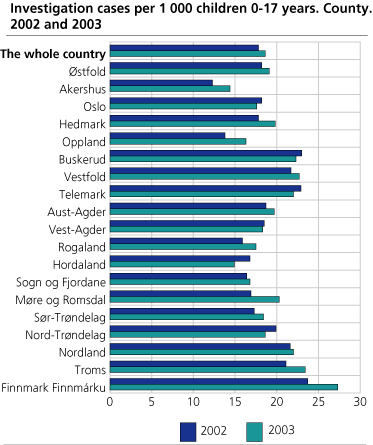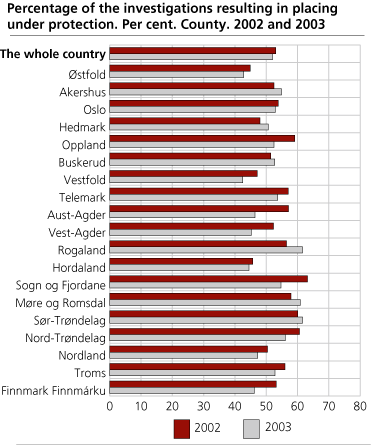Content
Published:
This is an archived release.
Increase in child welfare investigations
The child welfare service started a total of 20 100 investigations in 2003. This is about 900 more than in 2002 and an increase of 4.7 per cent. In more than half of the investigations that were completed in 2003 the child was placed under protection.
19 investigations were started per 1 000 children aged 0-17 in 2003, compared with 18 in 2002. Investigations involving boys were more common than those involving girls. For the age group 13-17, which is the largest group, 22 investigations were started per 1 000 children. A total of 20 200 investigations were completed in 2003, and 52 per cent resulted in intervention.
The statistics only contain data on who reported the incidents resulting in an investigation. In other words, the population does not include all reports to the child welfare service, but only reports that resulted in investigations. Several people or institutions may be behind one report.
Considerable differences between counties
There are considerable differences between counties in terms of the number of initiated investigations and investigations that result in the child being placed under protection. With 27 investigations per 1 000 children aged under 18, Finnmark county has the highest number of investigations, followed by Vestfold, Buskerud, Telemark and Nordland. Akershus has the lowest number of investigations with 15 cases per 1 000 children.
Intervention in more than half
52 per cent of the investigations led to intervention pursuant to the Child Welfare Service Act. 47 per cent were shelved without intervention. For 1 per cent of the cases, the conclusions are unknown. In the top-ranking counties Rogaland and Sør-Trøndelag, almost two out of three investigations (62 per cent) resulted in the child being placed under protection. In Møre og Romsdal county this applied to 61 per cent of the cases. In the counties of Vestfold, Østfold, Hordaland, Vest-Agder, Aust-Agder and Nordland, less than half of the investigations resulted in intervention.
In 31 per cent of the investigations that were started last year, the child itself, his or her family or neighbours contacted the child welfare service. In 22 per cent of the cases, the parents made the contact. Neighbours accounted for 3 per cent of the reports leading to an investigation, whereas the child welfare service and schools were behind 12 and 11 per cent of the reports respectively. The police and emergency child protection centres accounted for 9 and 7 per cent, while health stations and kindergartens were the reporting body in 5 and 3 per cent of the investigations.
Content of reports
In one out of five cases (22 per cent) neglect/abuse was the reason for a report leading to an investigation, and 17 per cent were due to the child having behavioural problems. Conditions in the home and special needs were the reason in just over half of the cases (55 per cent).
Six-month processing time in five per cent of cases
According to the Child Welfare Services Act, the child welfare service is required to undertake all investigations without delay within three months after a case has been reported. In special cases the deadline can be extended to six months.
Of the 20 177 investigations that were completed in 2003, 71 per cent were completed within the three-month deadline. A further 24 per cent were completed within six months, and in five per cent of the cases the processing time was longer than six months. Information is lacking for just under 1 per cent of the investigations. The average processing time in 2003 was 76 days, against 80 and 73 days in 2002 and 2001.
Tables:
The statistics is published with Child welfare.
Contact
-
Statistics Norway's Information Centre
E-mail: informasjon@ssb.no
tel.: (+47) 21 09 46 42


